Our Blog - Lombardy 2025 - Pavia, Italy
Our next stop was Pavia, a city I had never actually heard of before researching for this trip. The University of Pavia, which dates back to 1361, was recognized in 2024 as one of the top 10 universities in Italy. We only spent 1 day here, but there was plenty to see. I don't normally show pictures of where we stayed, but this one was not your "typical" B&B! What a gorgeous totally-Italian-style building, and in the bedroom, it has the original painted wood ceiling! And all around, there are wonderful little balconies, like in the 4th picture.
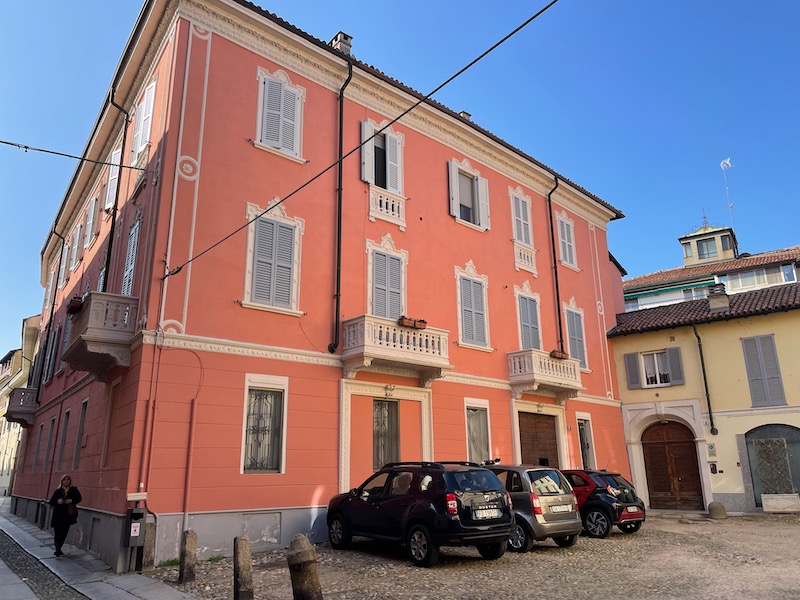

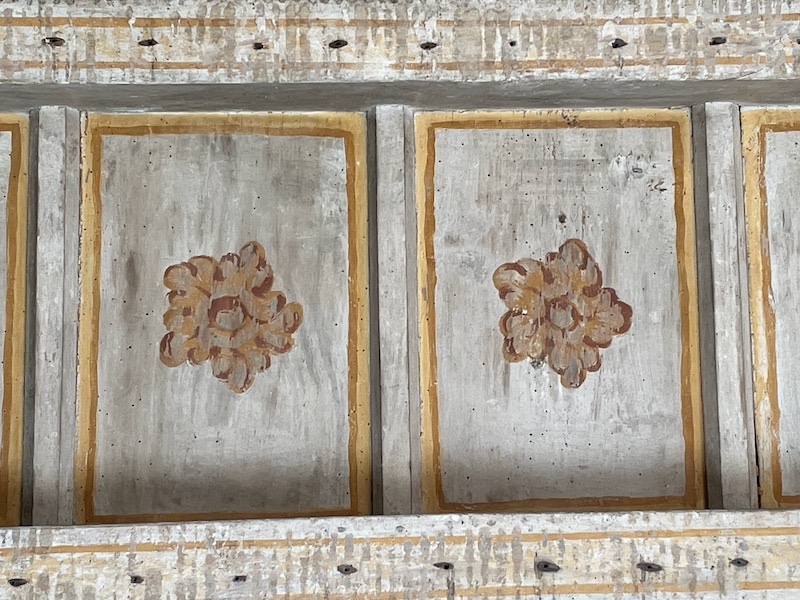
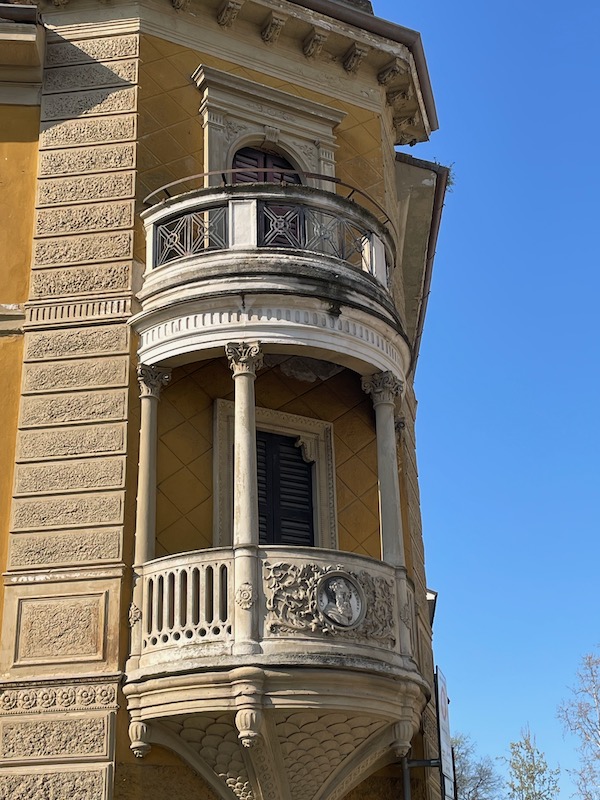
The Cathedral of Pavia, dedicated to Santa Maria Assunta and Santo Stefano (the first martyr), was begun in 1488 but not completed until the end of the 19th century. The central dome, with an octagonal plan, is the fourth largest in Italy. There used to be a tower next to it, dating back to 1330, but it collapsed in 1989 for unknown reasons and has not been rebuilt.
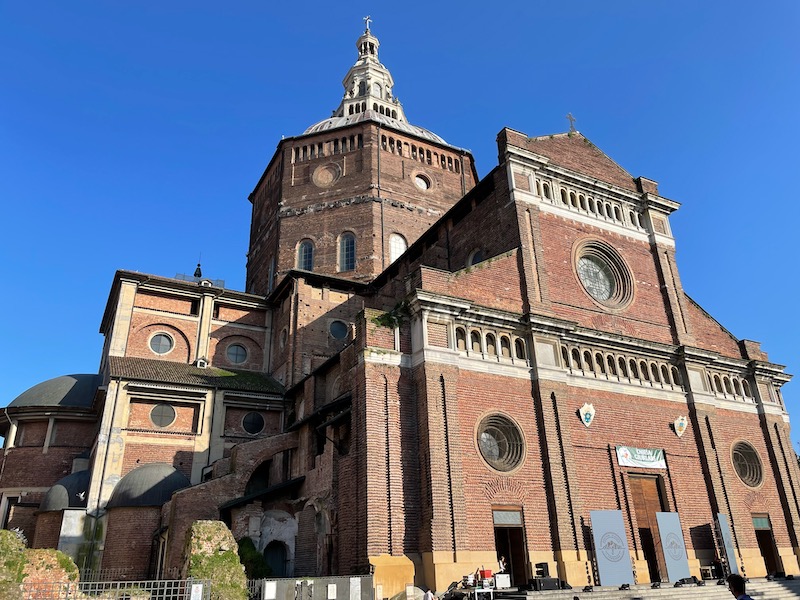
The interior is very "bland", in my opinion, but seems fairly normal for Cathedrals. The pure Renaissance architectural lines give an impression of great grandeur, amplified by the brightness of the very white marble cladding. The church contains a silver reliquary containing 3 thorns (supposedly) from the corwn placed on Jesus' head during the Passion.
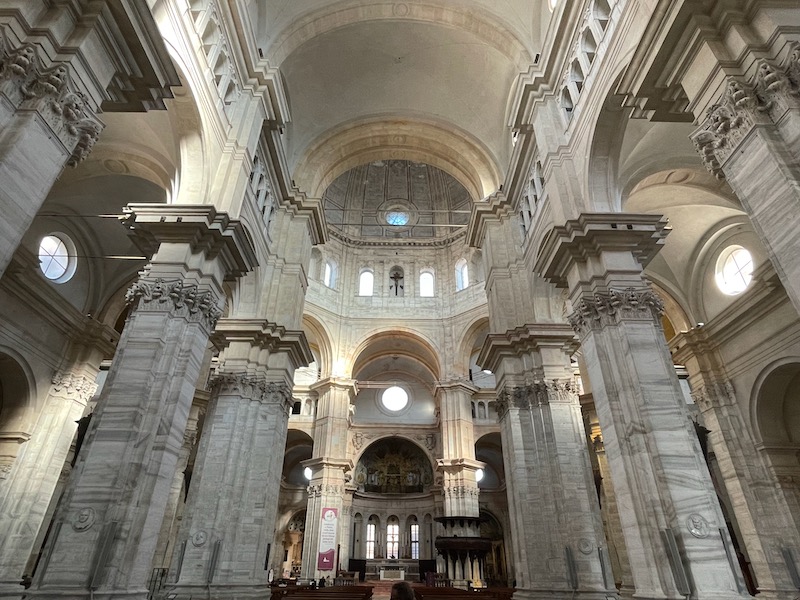
This is the altar of San Siro, the first bishop of Pavia (3rd-4th century). Above the 19th century crystal urn with the remains of the saint is a large altarpiece in white marble and alabaster. The bas-relief depicts the Virgin handing over the keys of the city to San Siro with angels holding the iconographic symbols of the saint, the processional cross, the book of the Gospels and a basket with loaves and fish.
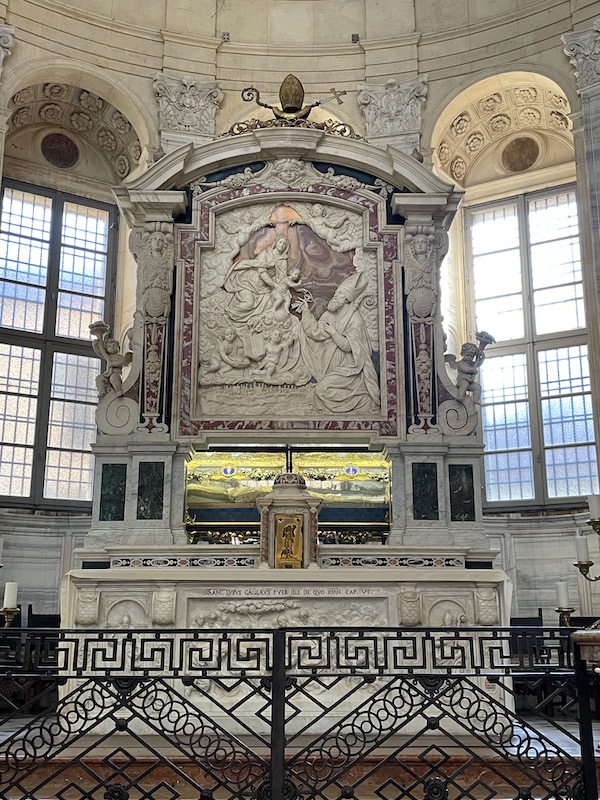
The Chapel of the Madonna del Rosario contains a large painting from 1827 depicting the Madonna with the child, Saint Dominic and Saint Alexander. Around the main painting are smaller paintings of the 15 mysteries of the Rosary.
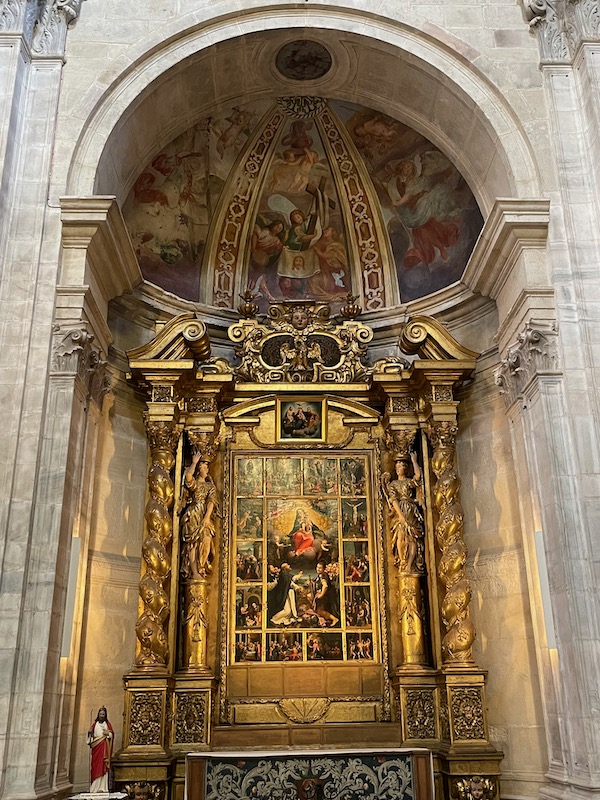
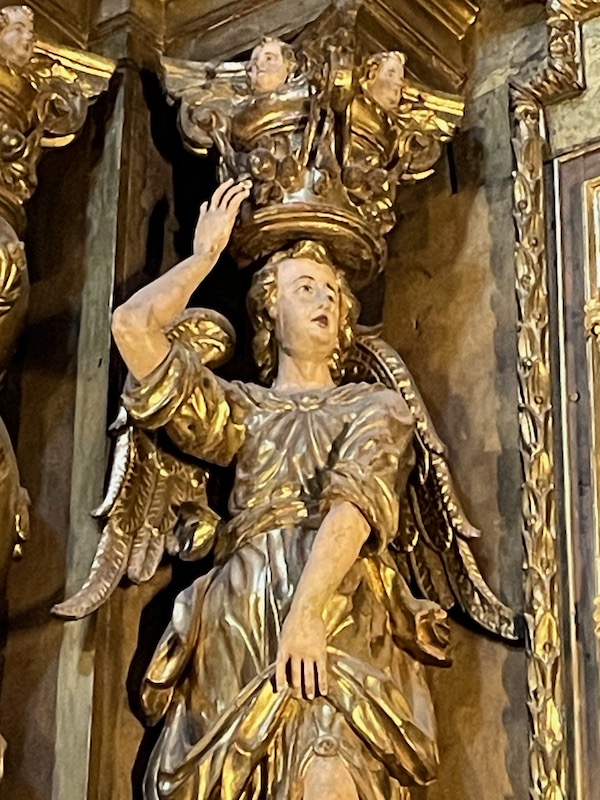
I mentioned the thorns from the crown ... while this is not the actual silver reliquary, it is a picture of it (the real one is locked behind a door that takes 3 different keys from 3 different people to open).
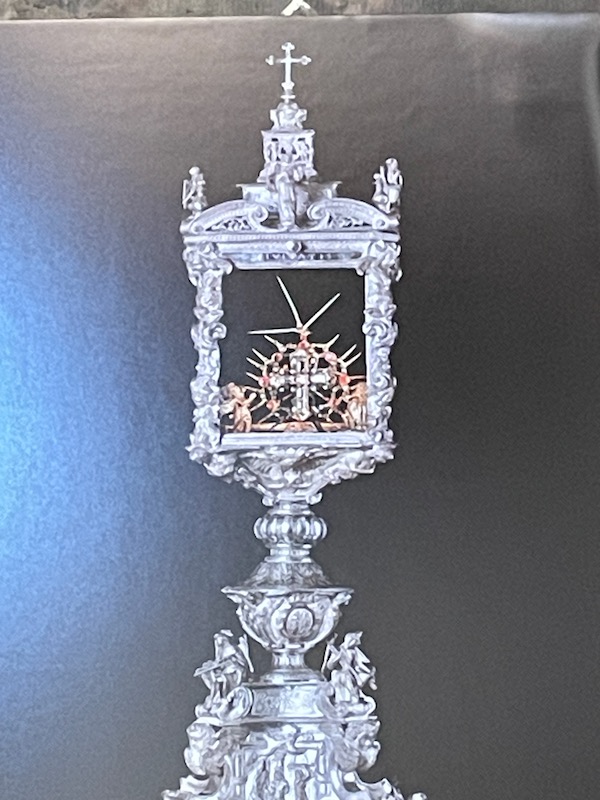
The Chapel of Saint Alessandro Sauli, who was bishop of the city at the end of the 16th century. The altar has a marble decoration, with statues and paintings in Rococo or Baroque style. In a bronze medallion, the saint is depicted with a large cross while preaching in Milan, in Piazza dei Mercanti. In semi-dome above, there are angels flying on clouds, among golden rays.
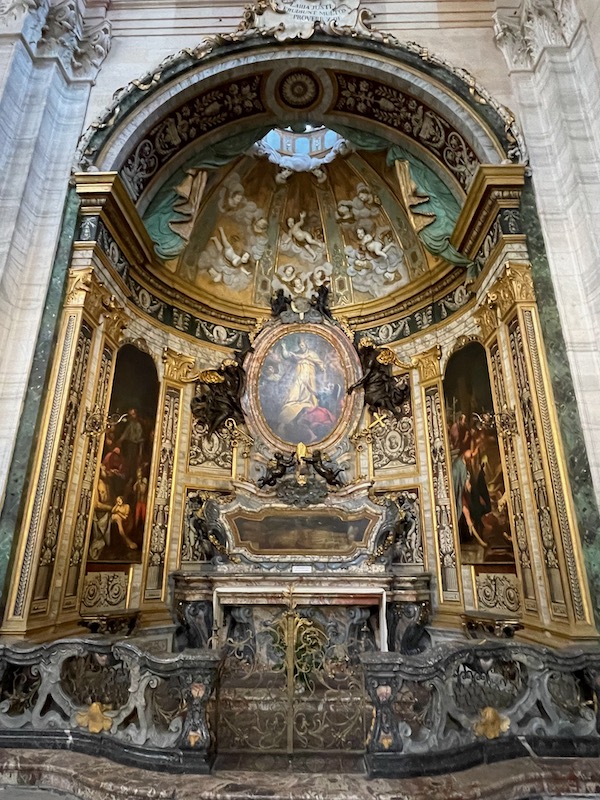
In the past, the "twin" cathedrals of Santo Stefano and Santa Maria Maggiore, commonly called Santa Maria del Popolo, stood on the area currently occupied by the cathedral. There are some remains of those cathedrals, that were demolished to create this one, in a small area on the side.

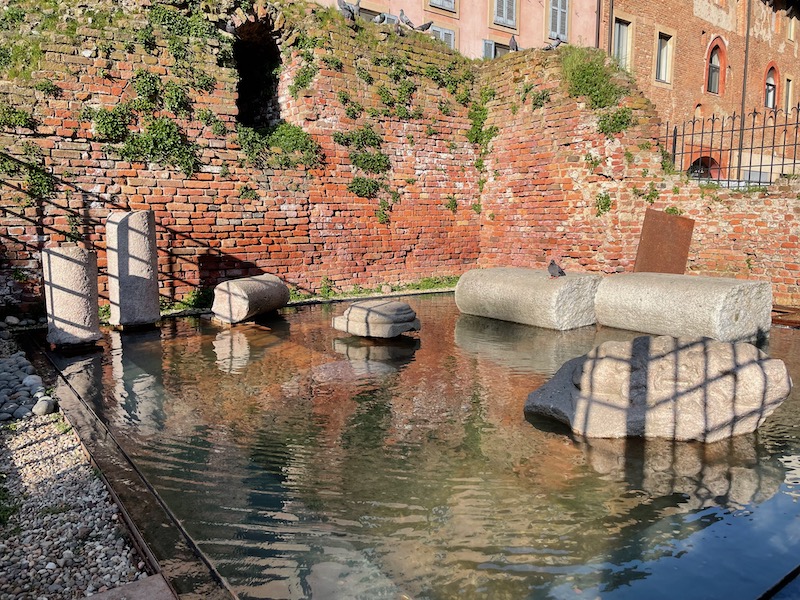
The Visconti Castle of Pavia (called the Castello) is a medieval castle built around 1360 by Galeazzo II Visconti, Lord of Milan, and used as a sovereign residence by him and his son Gian Galeazzo, first duke of Milan. Each wing has 2 floors, each had a series of 11 square rooms (each room had a single mullioned window that you can see today on the exterior). At each corner is a large, 4-story square tower, also with mullioned windows.
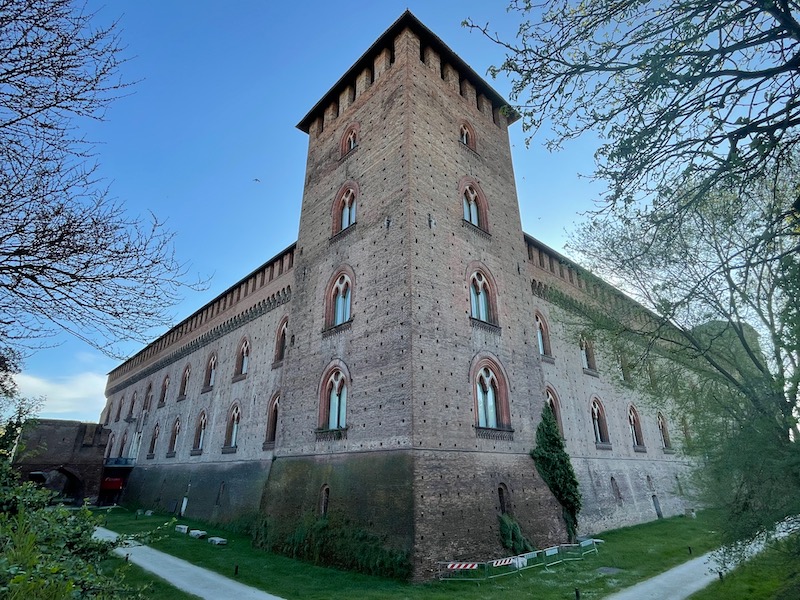
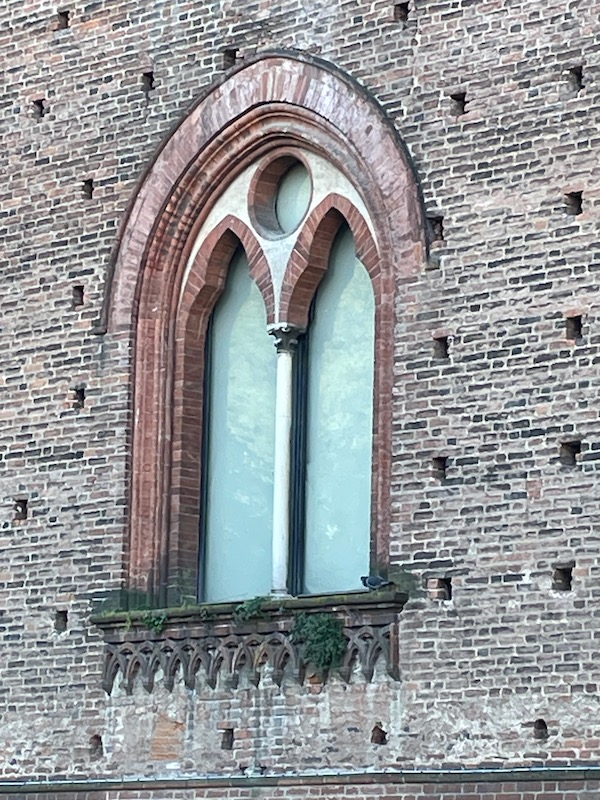
Construction of the Chiesa di San Francesco d'Assisi by the Franciscan community started in 1228 and was completed in 1298 along with a nearby convent. Unfortunately, the Franciscans abandoned the complex shortly after it was completed, ceding it to the Carmelites. In 1739 the church underwent heavy renovations (the interior of the building was plastered and covered with baroque stucco) which altered its original appearance, partly recovered thanks to the restorations undertaken between the end of the 19th century and the mid-20th century. The facade, dating from the end of the 13th century in Gothic style, is characterized by a decorative effect based on the contrast between the red of the bricks and the white of the sandstone.
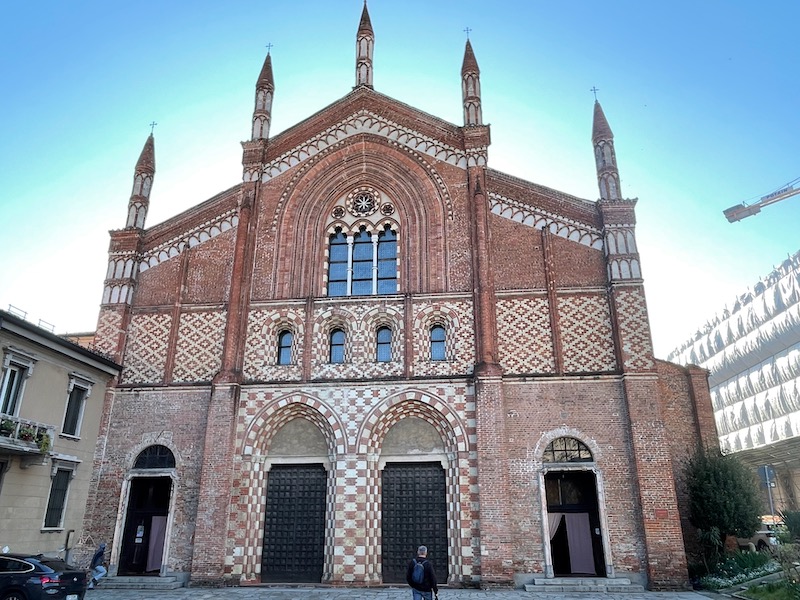

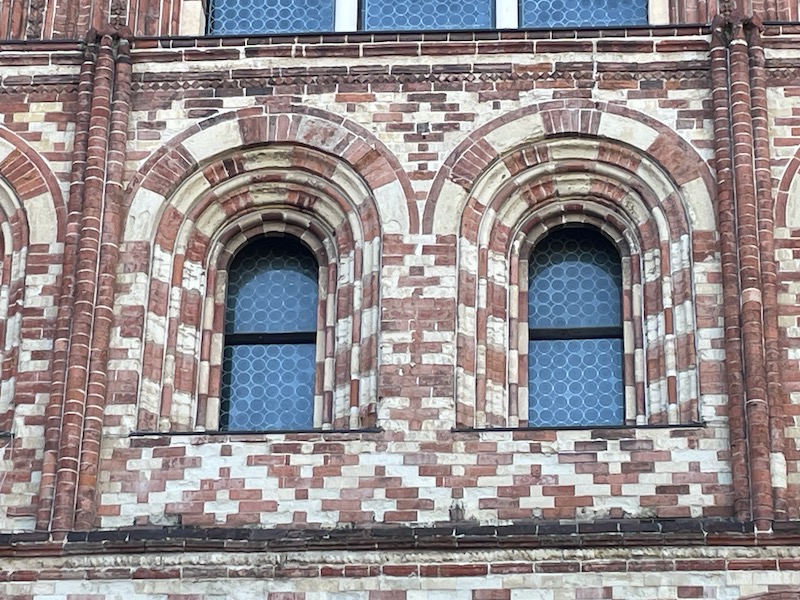
Inside, you can see the Romanesque arches separating the nave from the side aisles but more Gothic arches near the presbytery. You can also see two different types of roofs: the wooden roof in the central nave and the ribbed cross vaults in the side aisles.
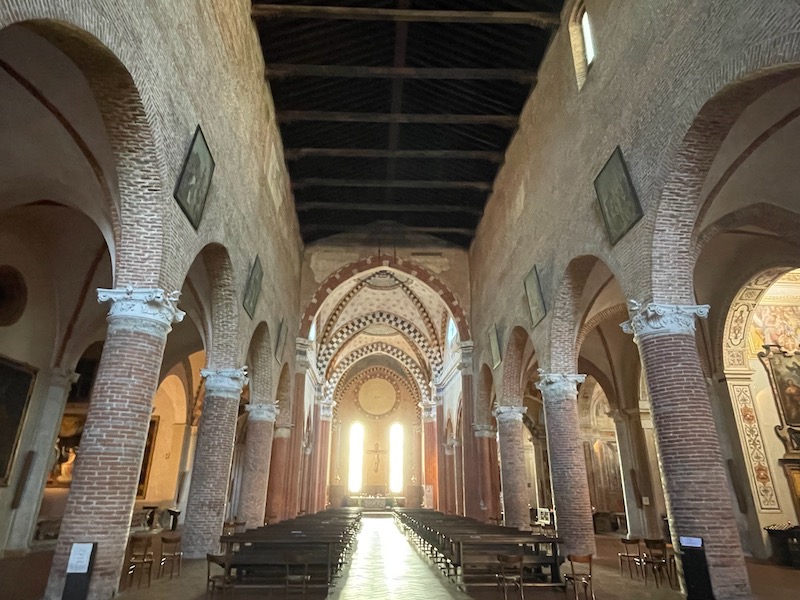
I mentioned the interior renovation and restorations earlier ... some of the old frescoes were able to be recovered when the plaster and stucco were removed. This first one has been dated to the second half of the 14th century.
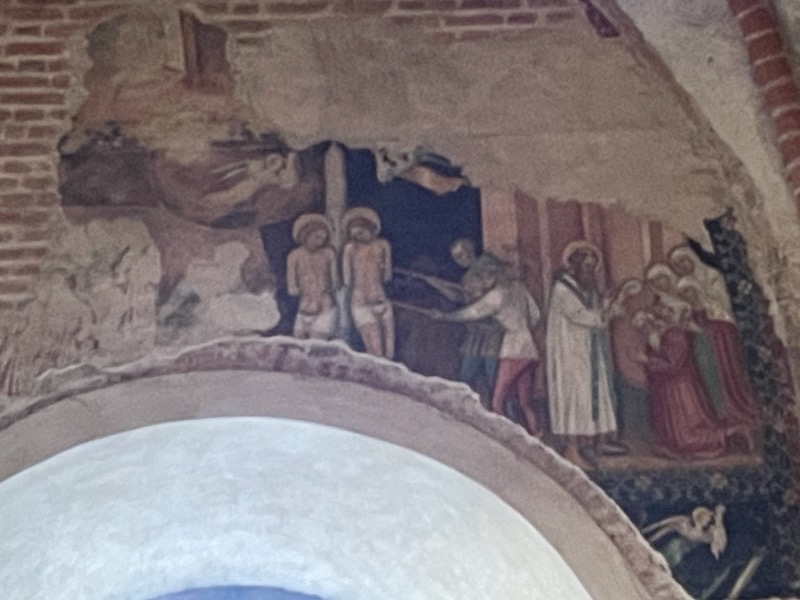
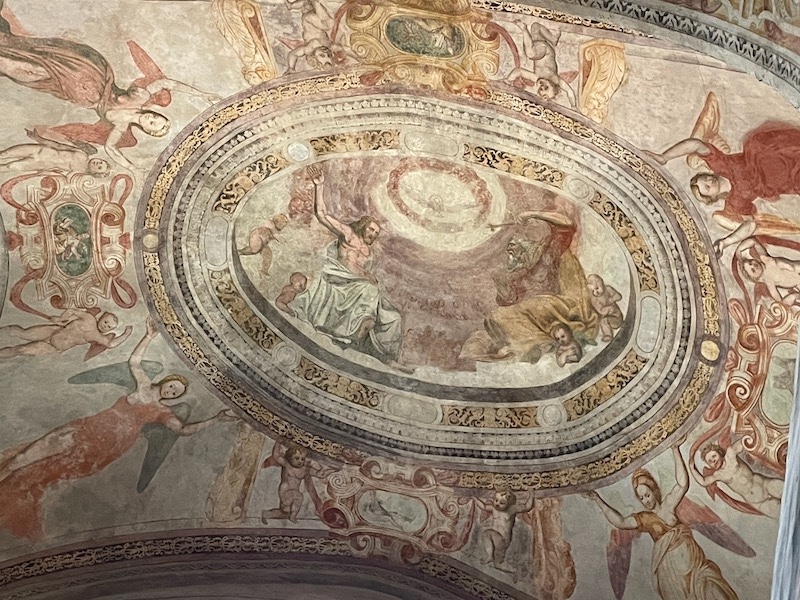
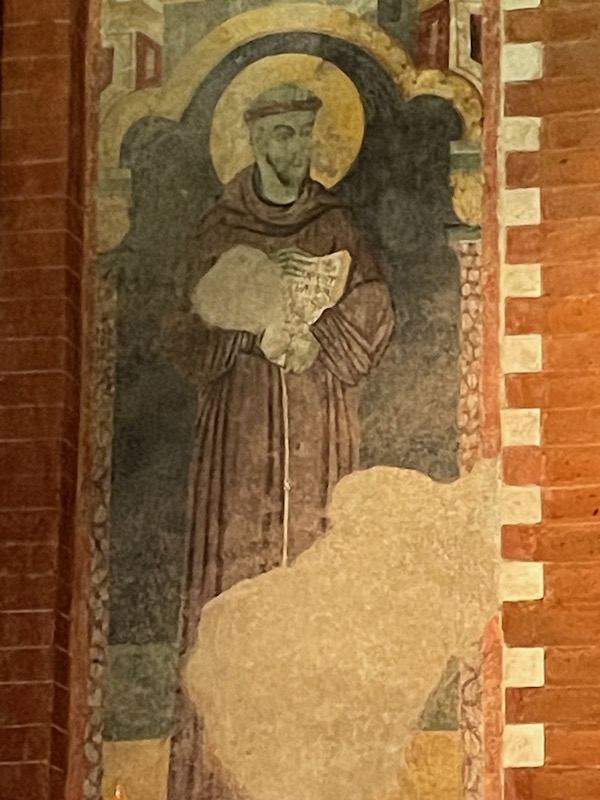
Many of the side chapels are decorated more elaborately than the rest of the church. Specifically, there are some really amazing ceilings!
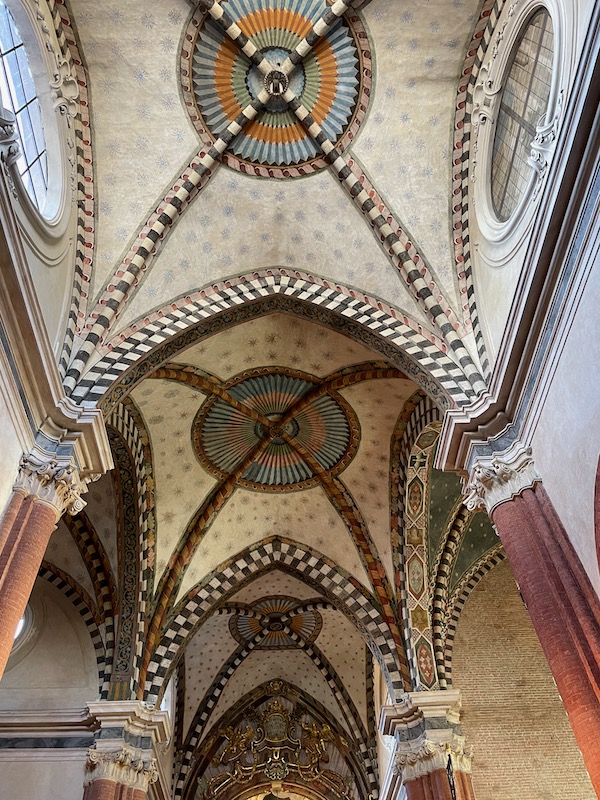
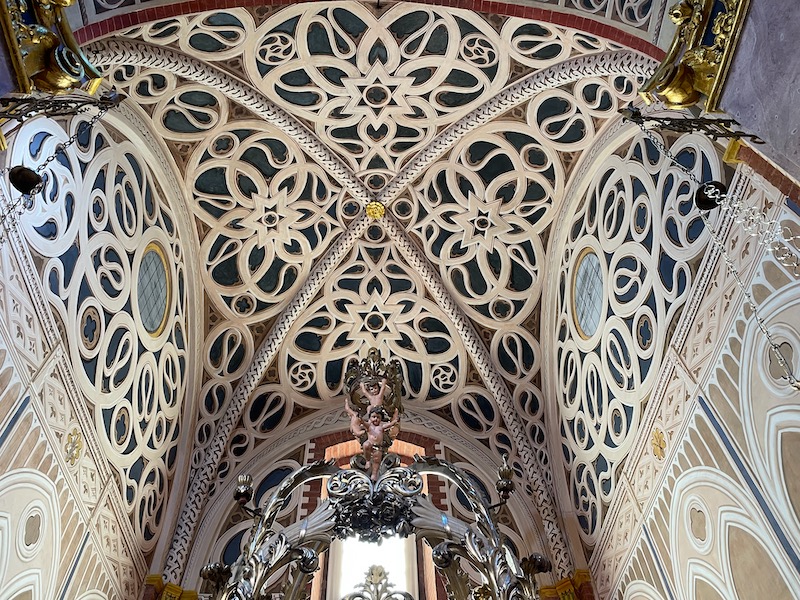
At the end of the transept is the chapel of the Immaculate Conception, commissioned in 1711. The chapel is decorated with marble, bronze and precious baroque decorations, and housed the treasure of the Company of the Immaculate (silverware, jewels and precious stones), until it was removed (or stolen) by the French in 1796.
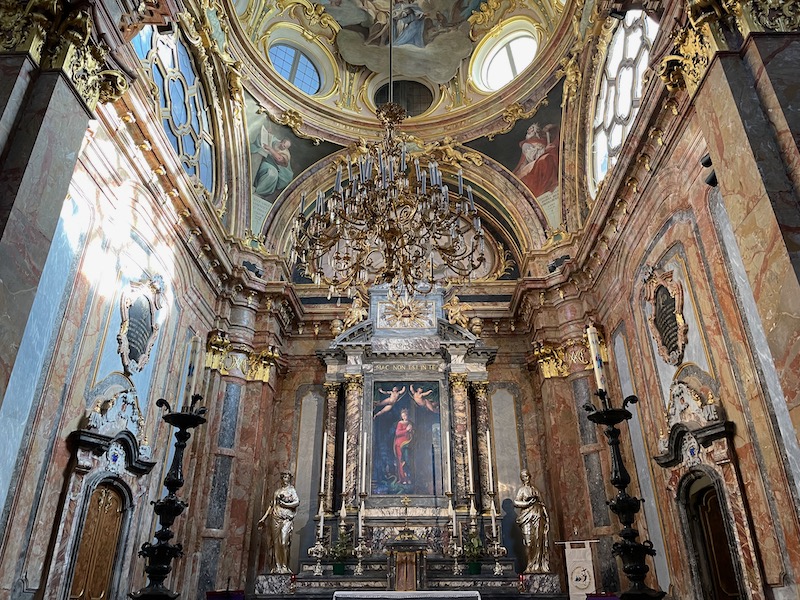
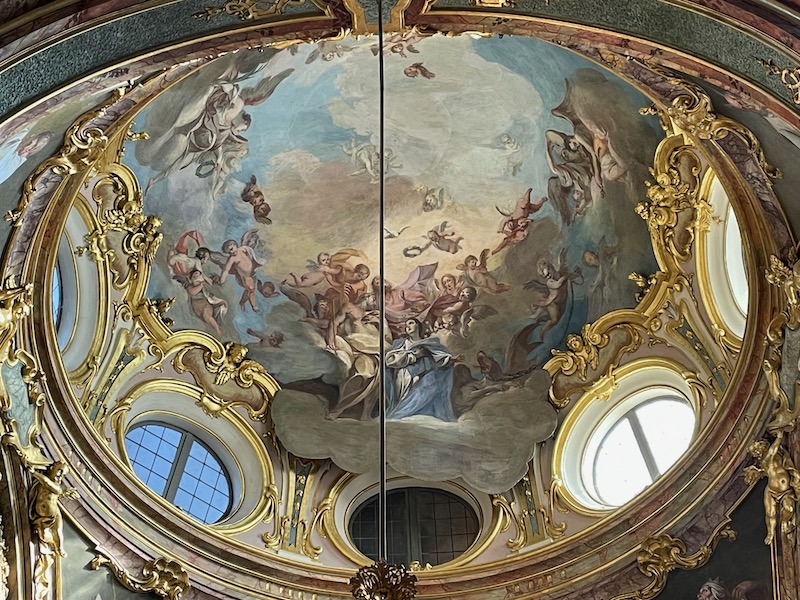
There are 3 medieval noble towers together in the center of Pavia, although I found it impossible to get a single picture with all 3 (you can find them on the web). If you remember the 16th-century fresco in the church of San Teodoro, it shows LOTS of towers in the city. Basically, a noble family would built a tower to show their power and wealth. I guess there were lots of powerful, wealthy families in Pavia in the Middle Ages!
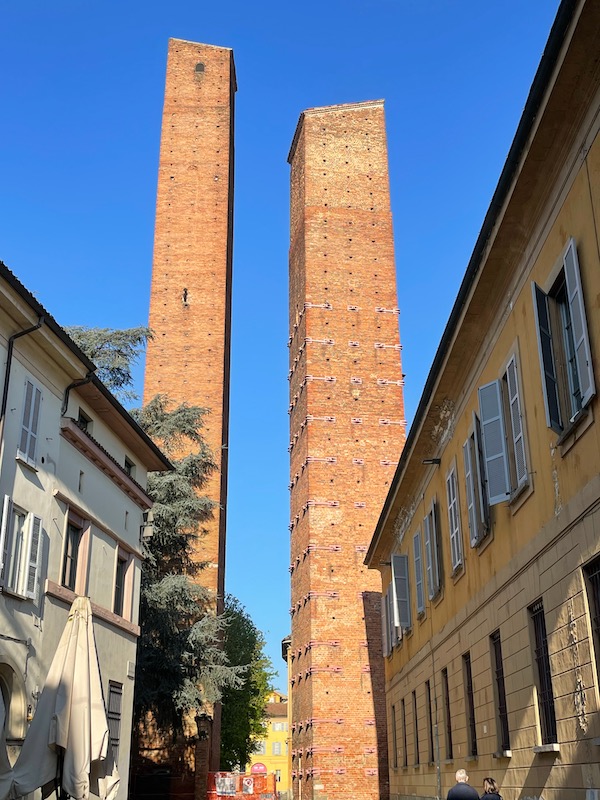
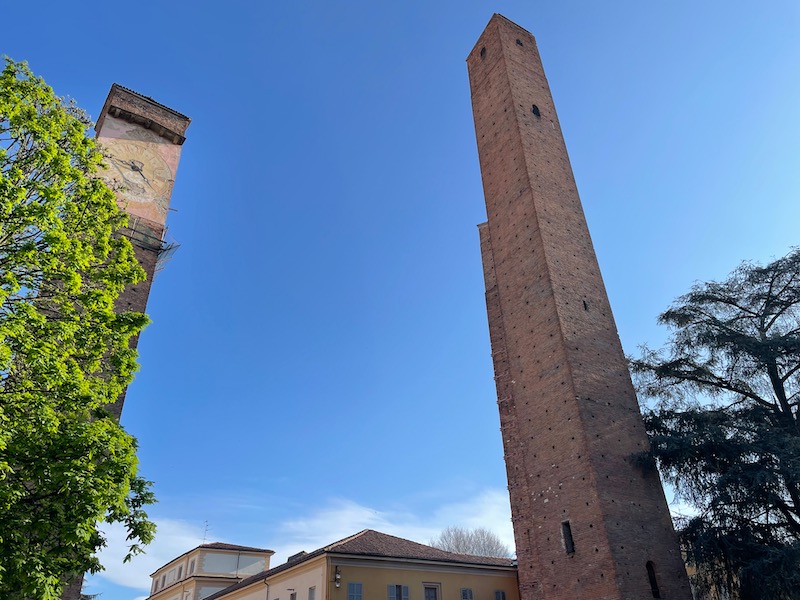
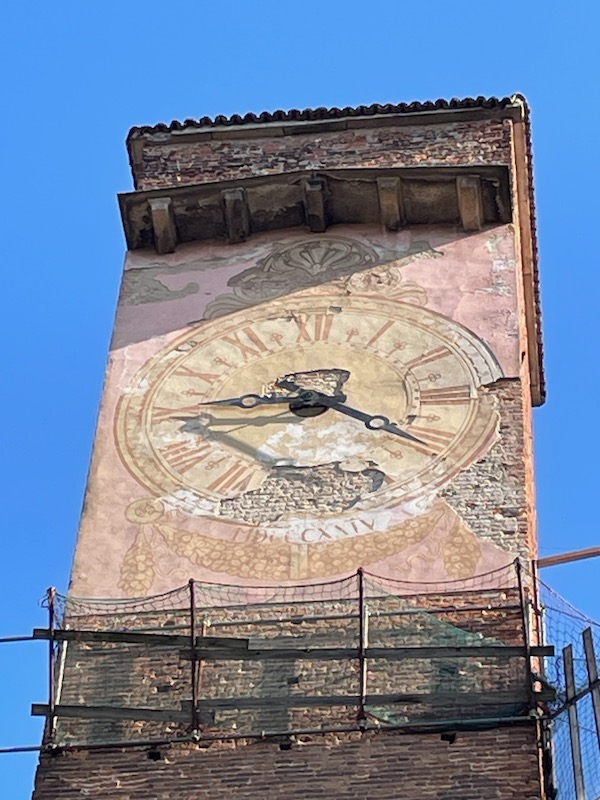
Basilica of San Michele Maggiore is one of the main churches in Pavia, dating back to the 7th century. The church differs in a few different characteristics from other churches in town. First, you can see the color ... fragile ochre-colored sandstone was used instead of terracotta and brick. It also has a more developed transept than others, extending past the body of the building so the building is not rectangular, like some others. The façade is adorned with sandstone sculptures, some more deteriorated than others. High above the main door is a restored sculpture of Saint Michael the Archangel and the Dragon.
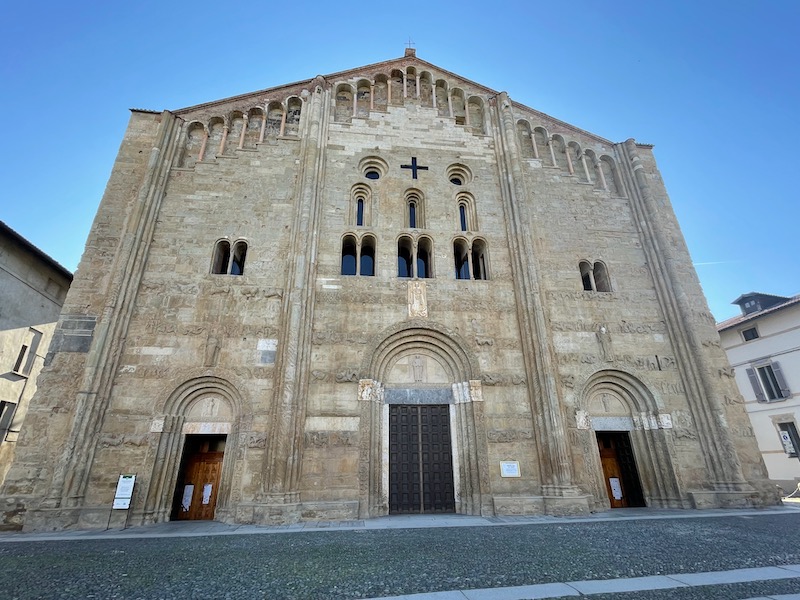
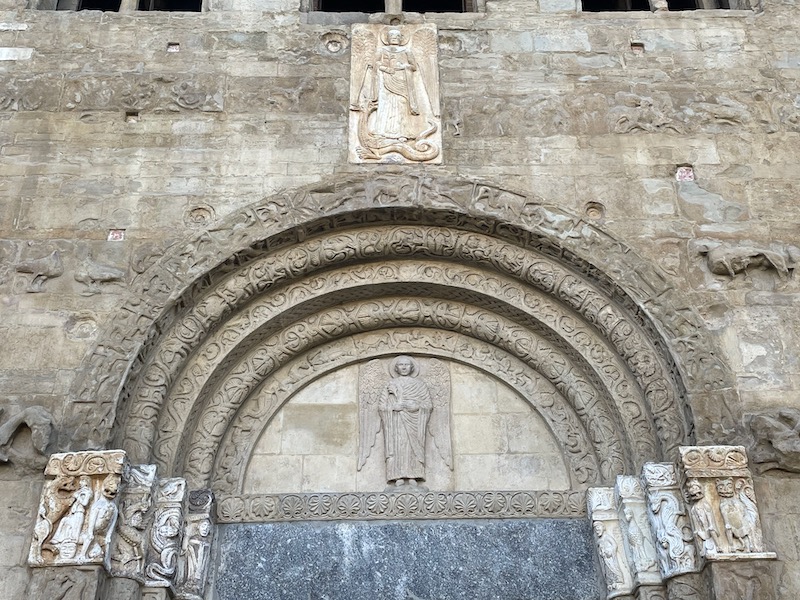
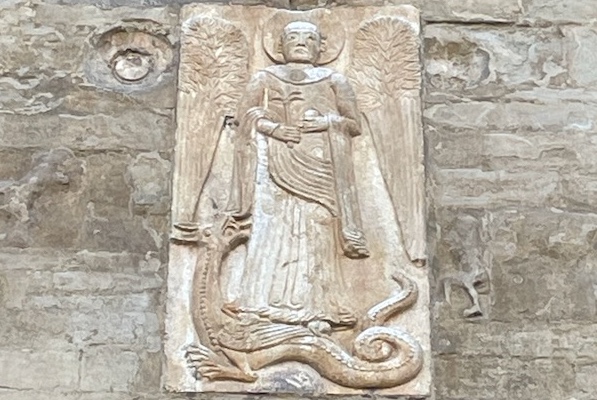
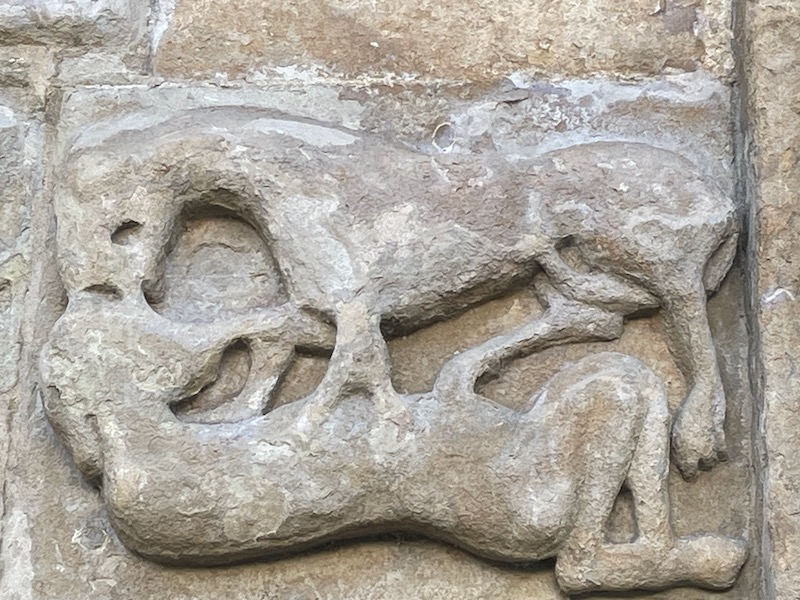
It was a bit dark inside but hopefully you can still see the Romanesque arches that separate the nave from the side aisles.
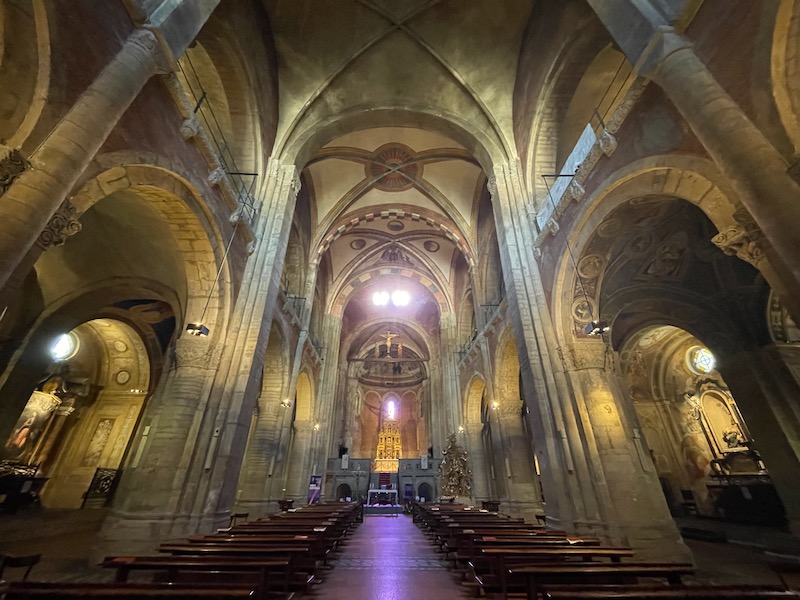
There were a few interesting altarpieces, including several that were 3D carvings.
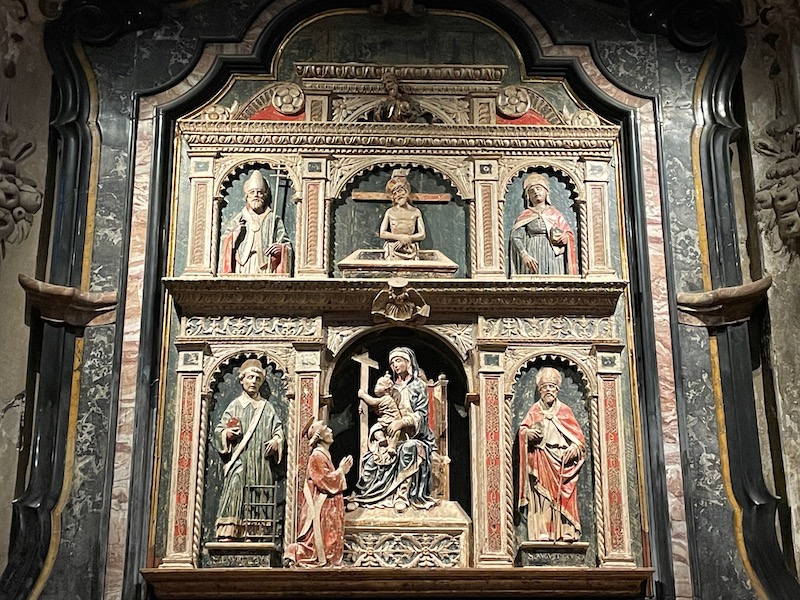
There are still old frescoes, most from the 15th century.
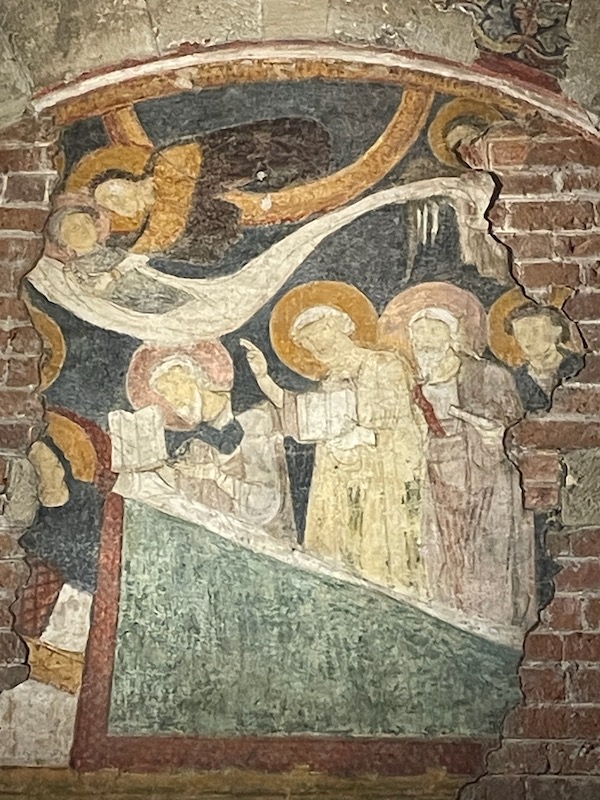
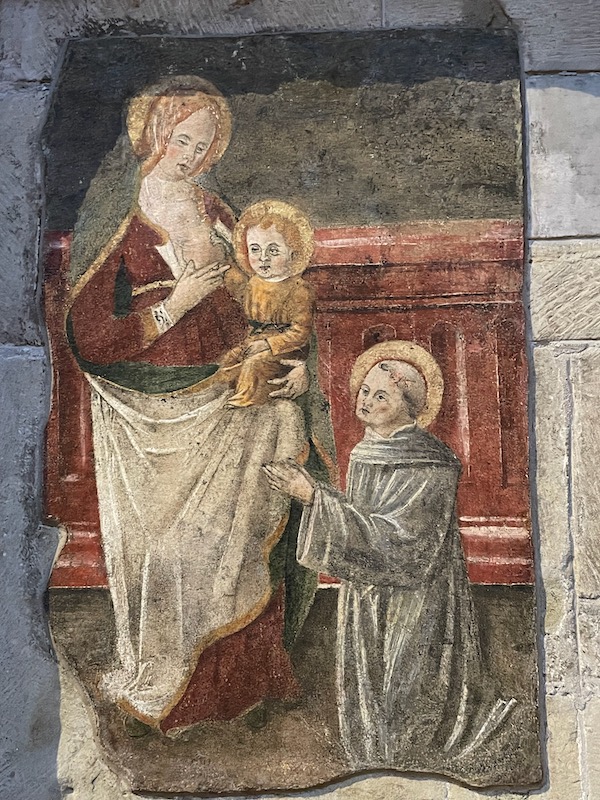
The main altar on the raised presbytery has a large altarpiece which contains relics from 3 saints.
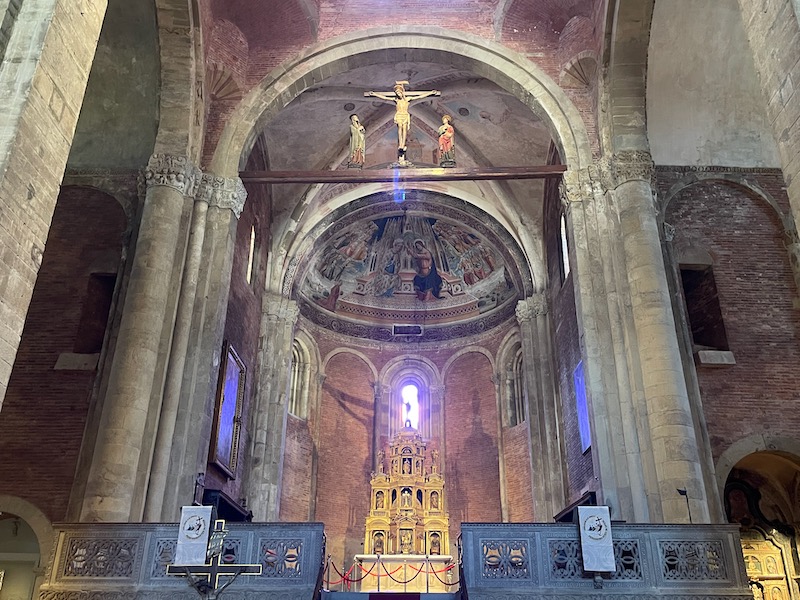
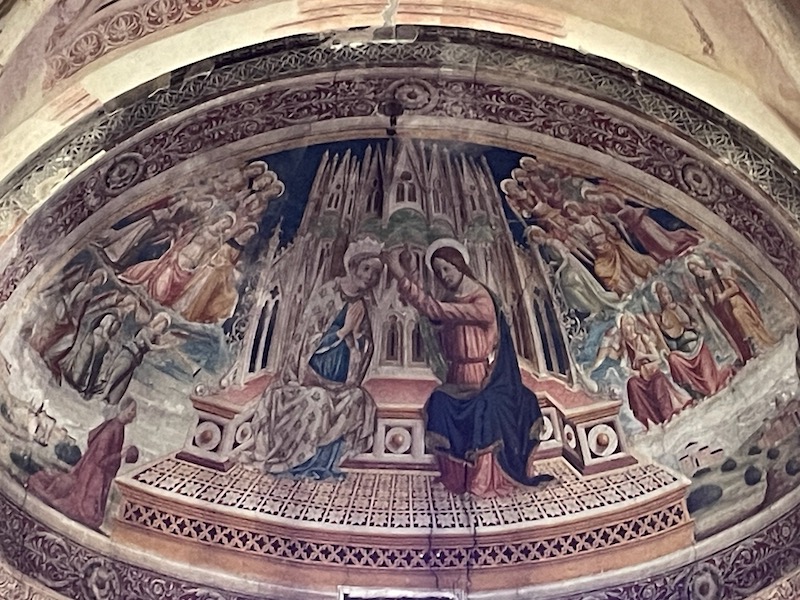
Here you can see the crypt, which sits under the raised presbytery. There are relics of 9 Saints inside the altar of the crypt.
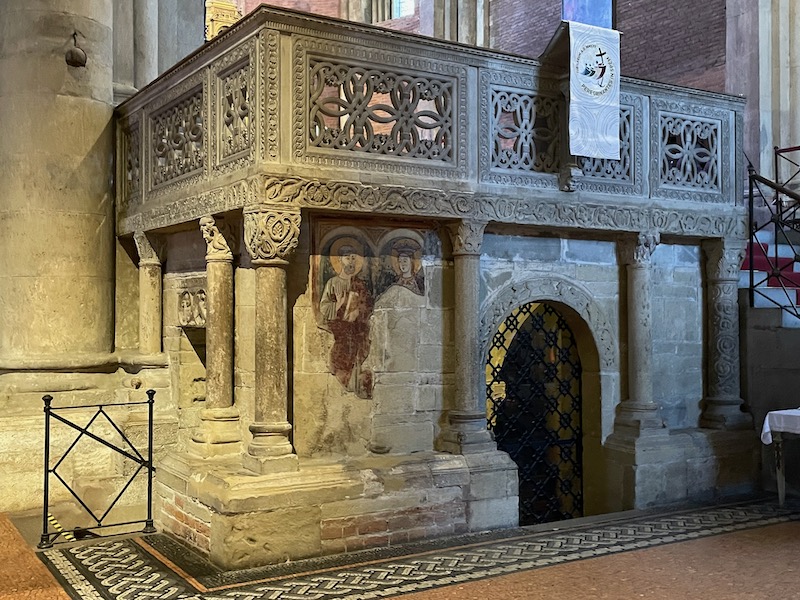
The Basilica of San Teodoro was built on a previous early medieval church dedicated to Saint Agnes which had been built in the the mid-8th century. After the remains of Saint Theodore were transferred here in the 12th century, the basilica was rebuilt and renamed. It was built in late Romanesque style in Lombard terracotta. Inside, you can clearly see the Romanesque arches in the naves and side aisles.
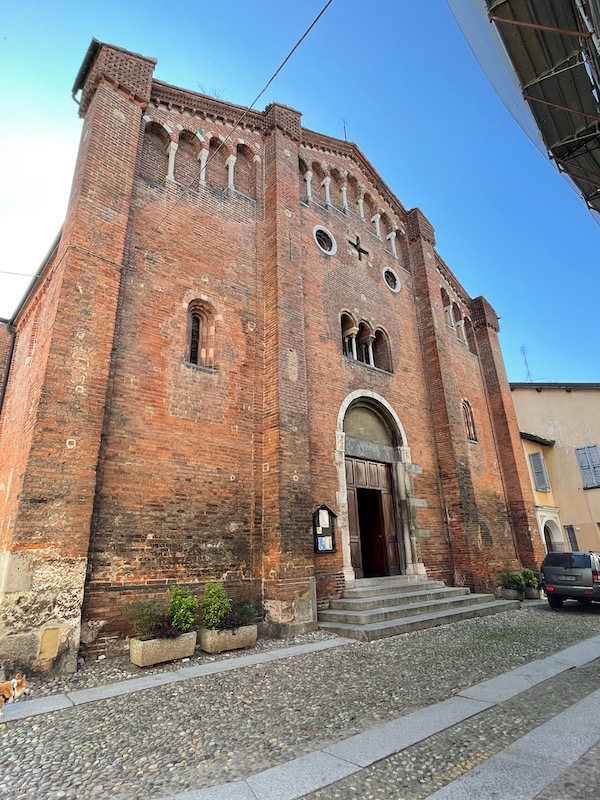
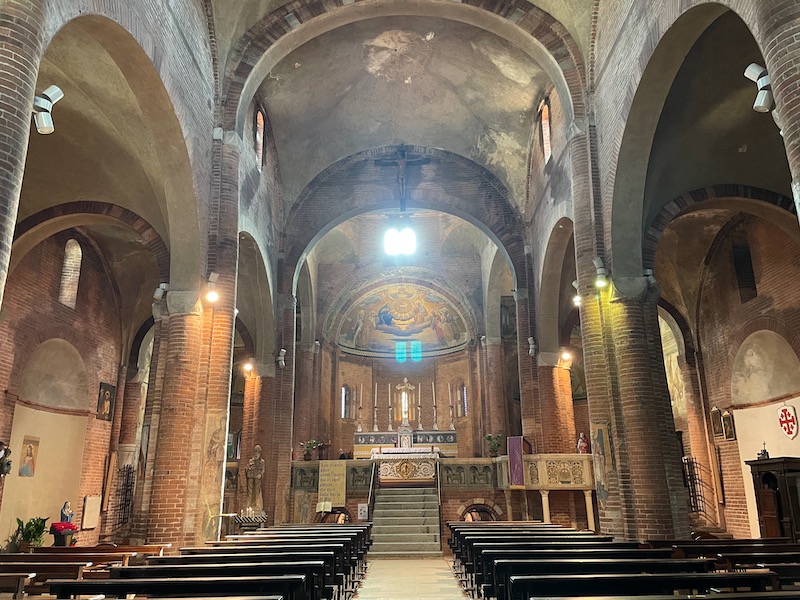
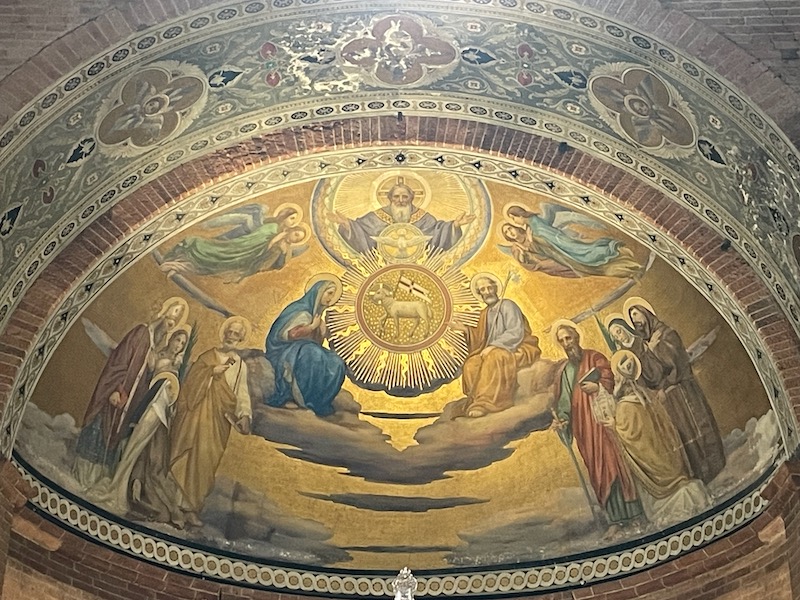
In 1998, during the work to redo the heating system, a medieval mosaic was discovered in the first span of the right nave, with scenes surrounded by bands with decorative and iconographic motifs typical of the Romanesque repertoire and are now visible under pieces of glass in the floor.
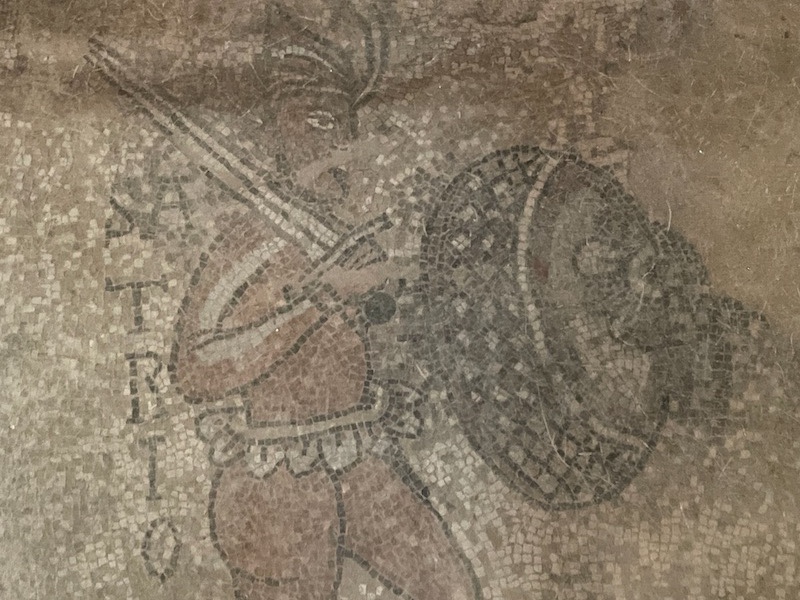
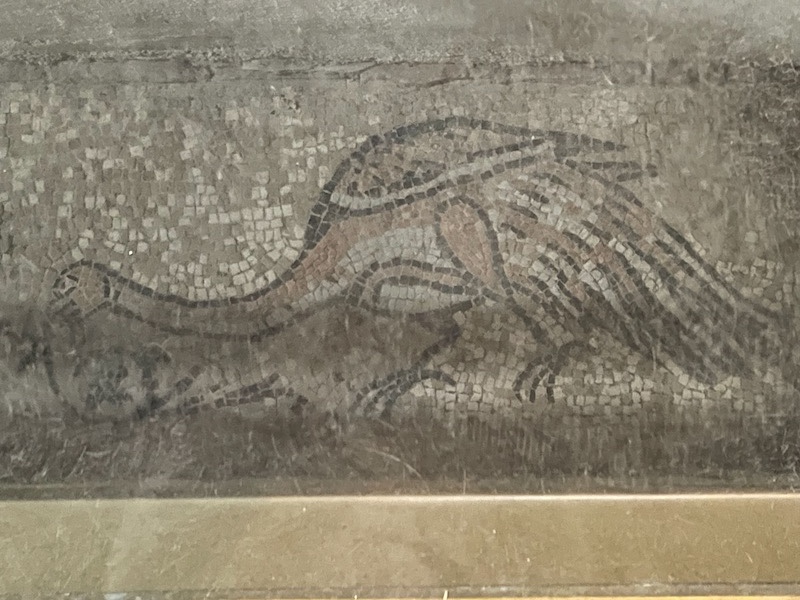
There are several important frescoes that date from the 13th century on the pillars of the central nave.
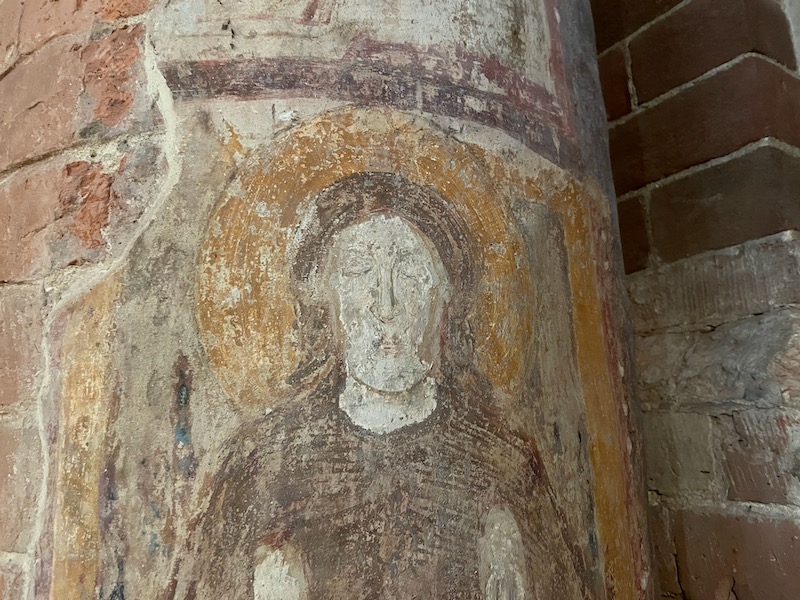
There are multiple frescoes that depict the life of Saint Theodore dating from 1514. They are based on the legend that Theodore was the savior of the Pavia when it was besieged by Charlemagne because it was protected with miracles by its bishop.
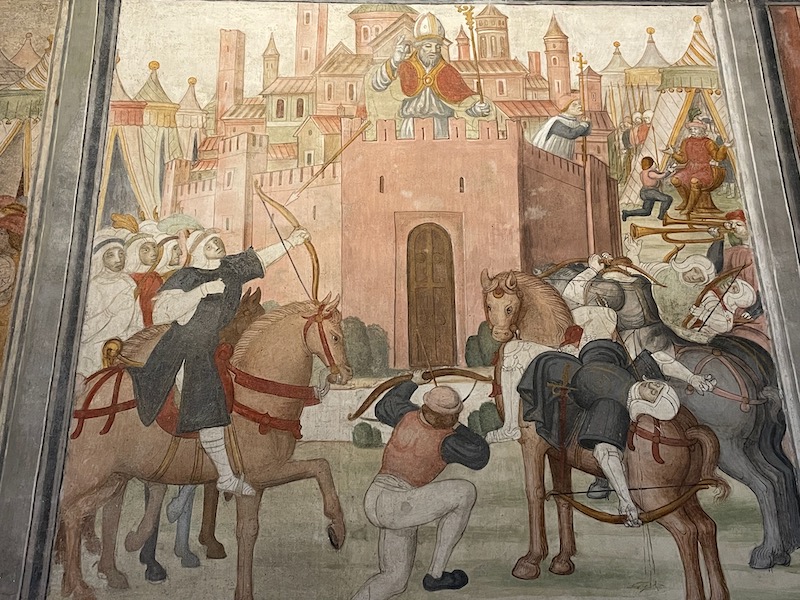
One of the interesting things with this fresco is that gives a detailed view of the city of Pavia from the 16th century.
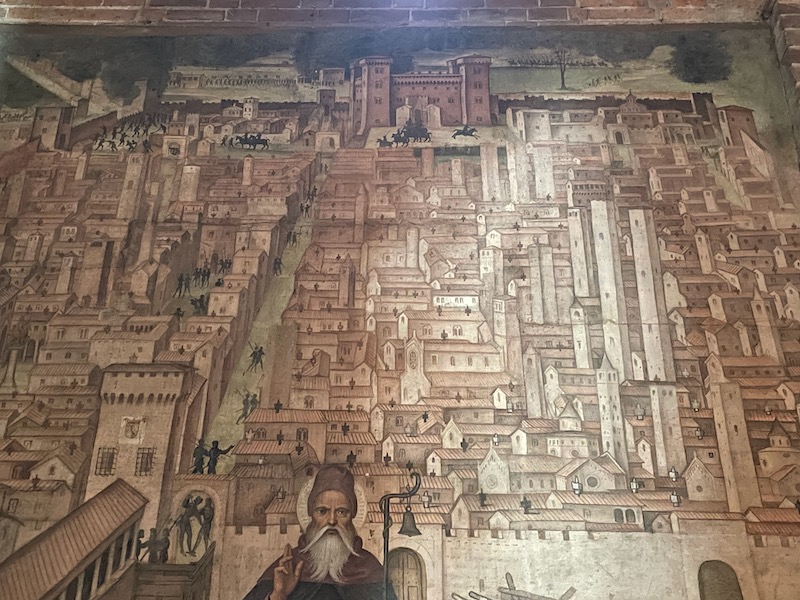
The covered bridge of Pavia is one of the symbols of the city. The 5-arched bridge is completely covered and there is a small chapel in the center. There was an original Roman bridge here in 218 BC that was restored in 860. If you remember the previous picture that has a fresco with the city of Pavia from the 16th century, the bridge is shown in there somewhere. It was mostly destroyed during WWII and rebuilt in the 1950's based on the design of the one in the Middle Ages, although with a few changes: The bridge was built about 30 meters further downstream than the previous one, compared to which it is wider and higher, as well as slightly shorter. The number of arches has also been reduced: five instead of seven, and positioned exactly perpendicular to the current of the river (while the old one was slightly off-axis).
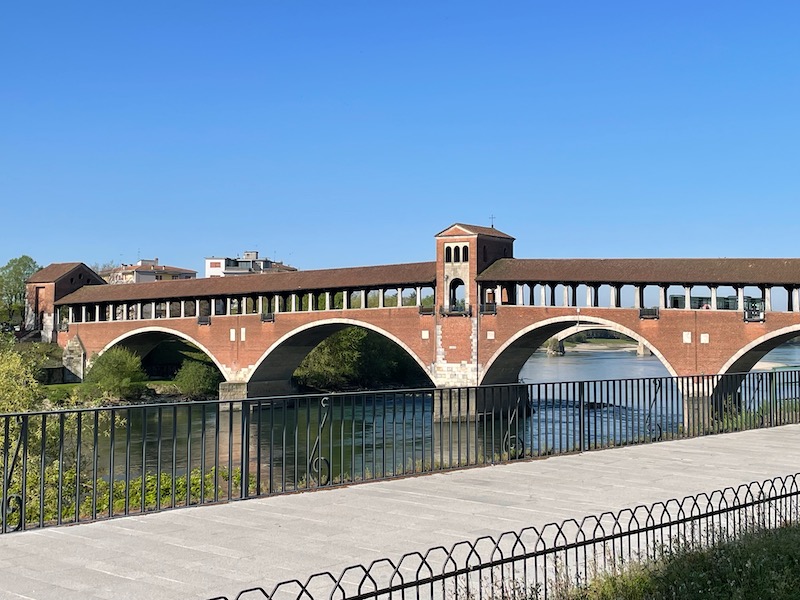
The Church of Santa Maria del Carmine is a well-preserved example of Gothic brickwork in northern Italy in the late 1300's. Built between 1374 and 1461, it is the second largest church in Pavia after the Duomo. The lunette over the main door have sculptures from 1854 showing the Annunciation.
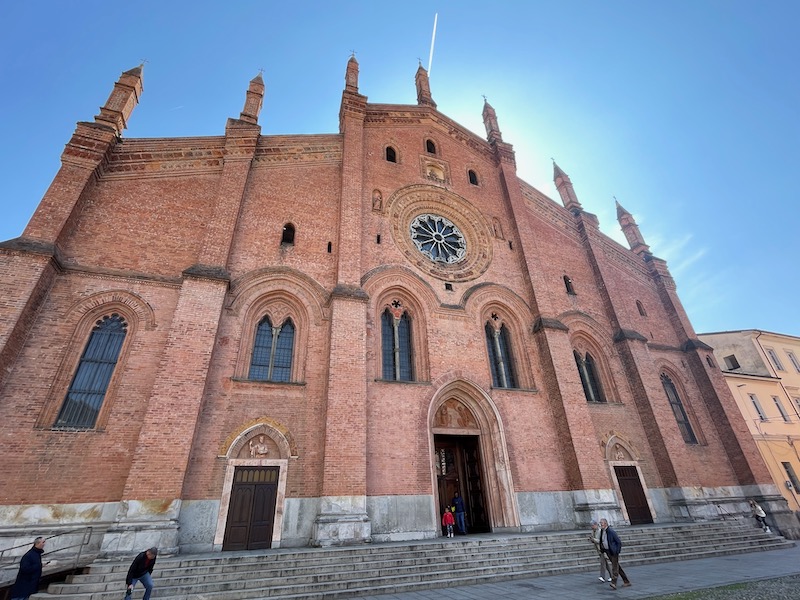
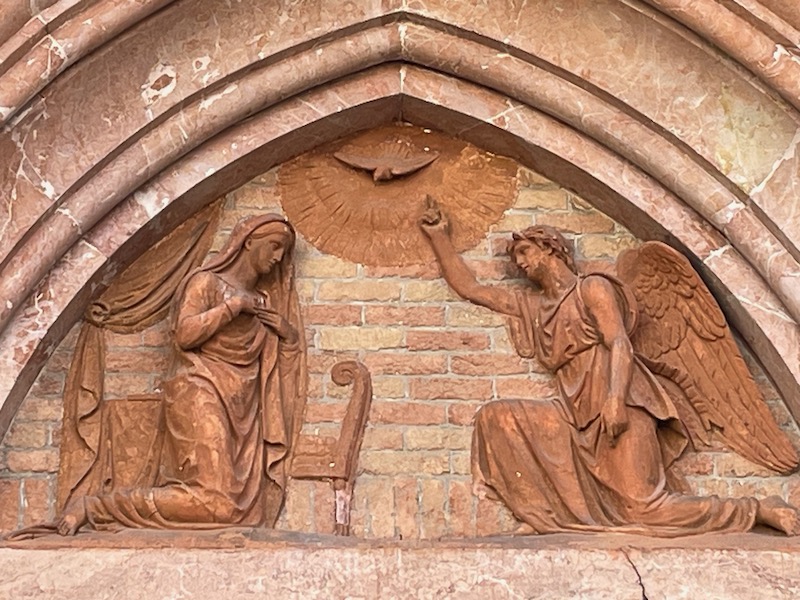
The plan is a large rectangle with a Latin Cross layout. The nave has 2 side aisles that contain square chapels. The vaults are cross-arched and the ribs that divide the structure of the vaults are in terracotta so as to form a chromatic element in contrast with the light plaster.
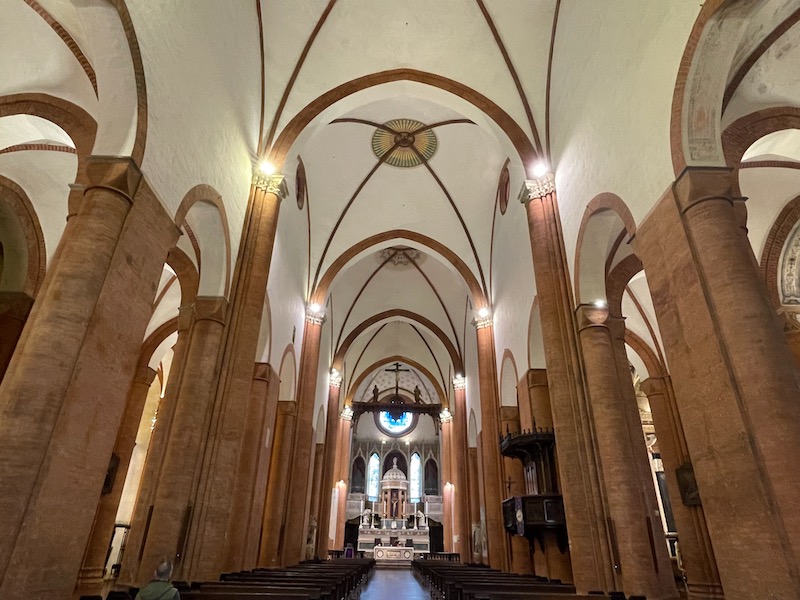
I don't know what chapel this altar is in, but I thought the altarpiece was amazing!
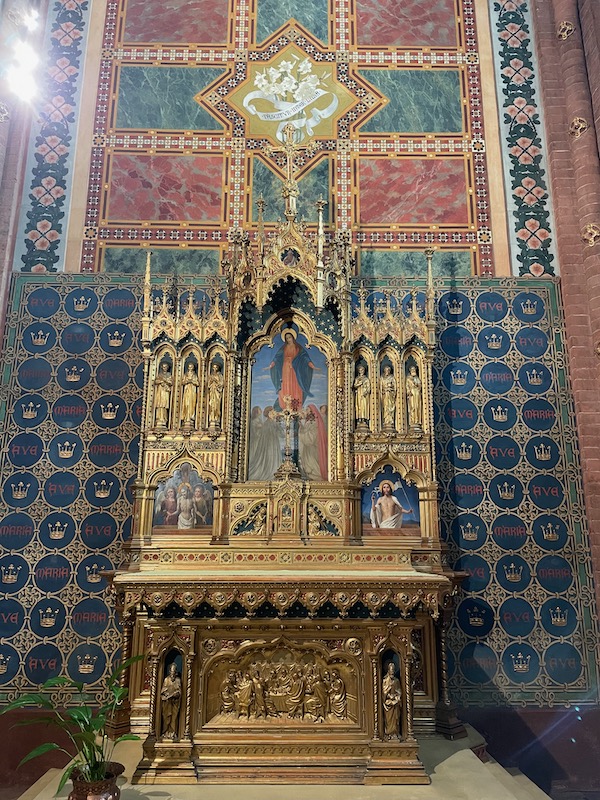
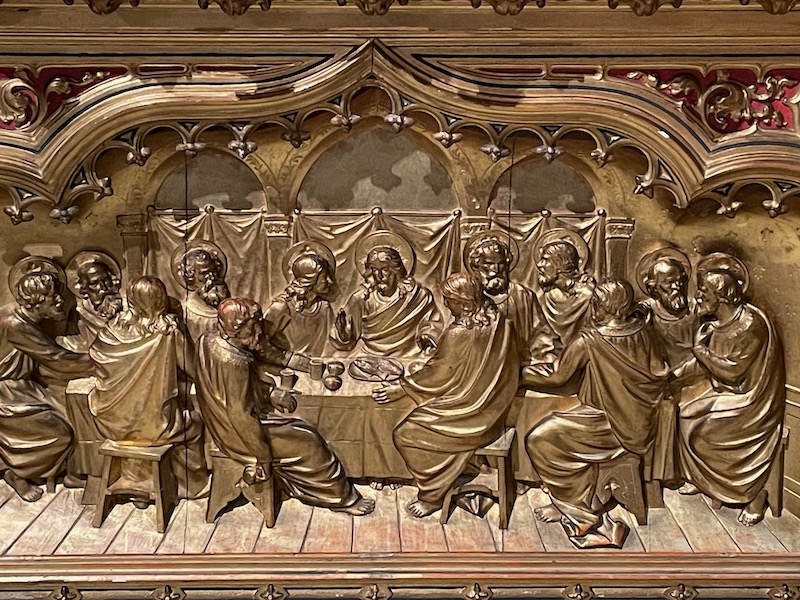
The main altar was redone in 1832. There is a small circular temple surrounded by angels. The interesting thing here is the window above the altar. It looks fairly modern, but in fact, there are 2 different pieces here. The outer section dates from a 1989 restoration, but the inner section contains a Madonna enthroned with Child, made between 1482 and 1489. I didn't get a close-up, but if you want to see what a stained-glass window from the late 1400's looks like, click here for a picture from Wikipedia.
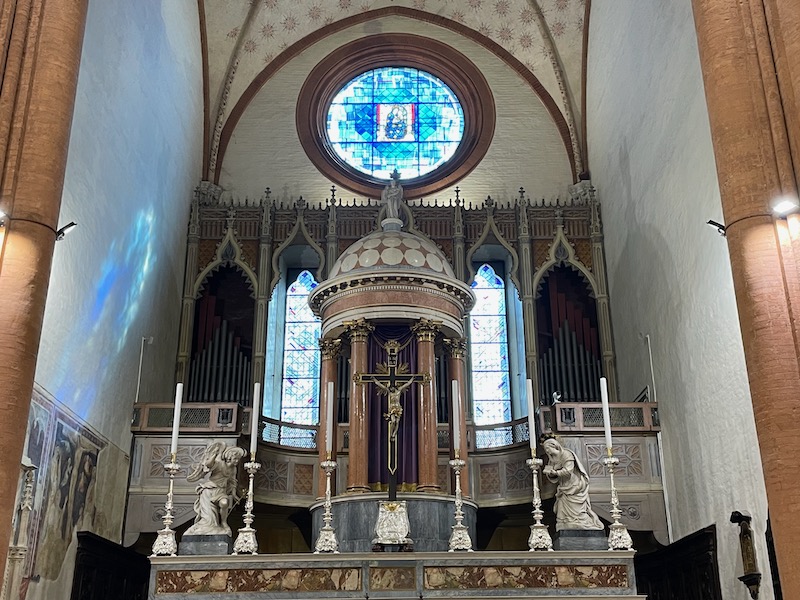
There are several frescoes around the church, some of them dating back to the 1500's.
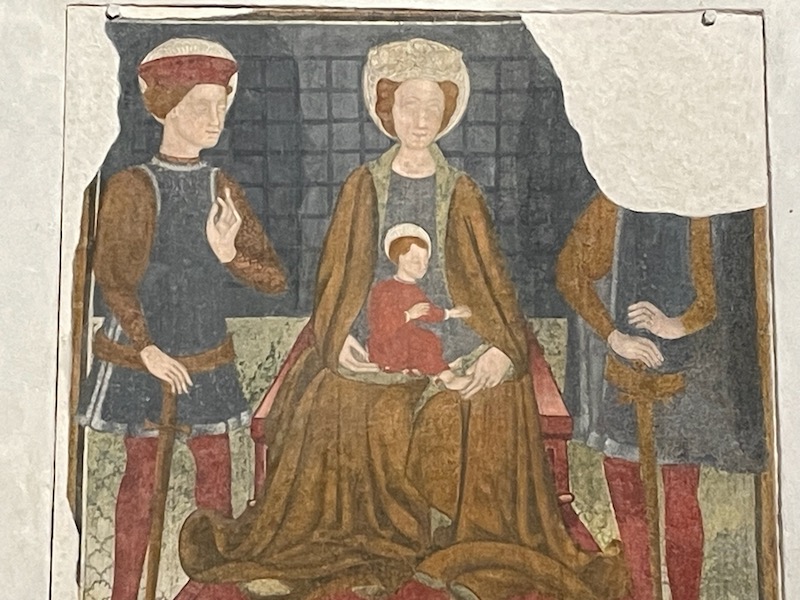
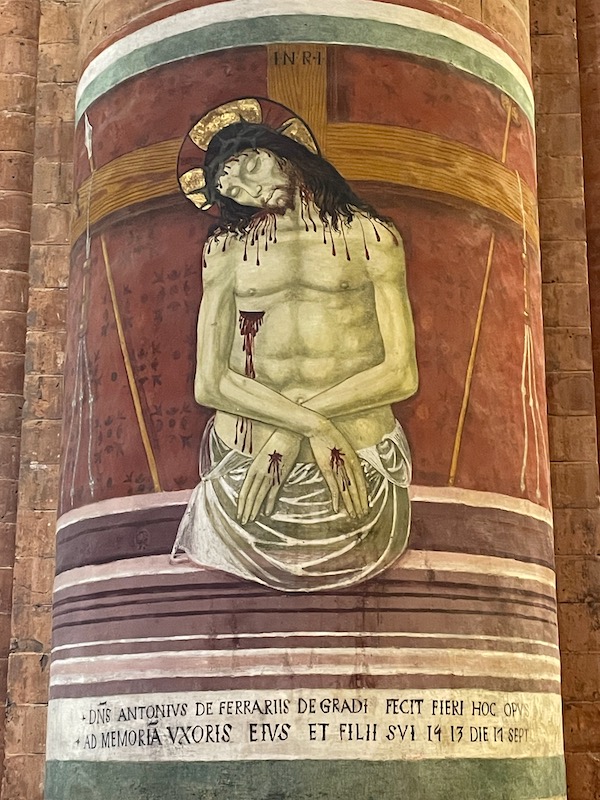
The Baptistery chapel was the last to be built, dating from 1490. The baptismal font was made of terra cotta in 1875 and is decorated by statues and medallions. The detailed picture shows the decoration: On the left pillar (partially cut off, sorry) is the statue of Charity, represented by a woman holding a child in her arms. Continuing to the right, on the tympanum there is the medallion of the evangelist Matthew, and in the center a medallion depicting the baptism of Christ, then the evangelist Mark. On the right-hand pillar is a statue of Faith, represented by a woman with a veil on her head and a torch in her hand.
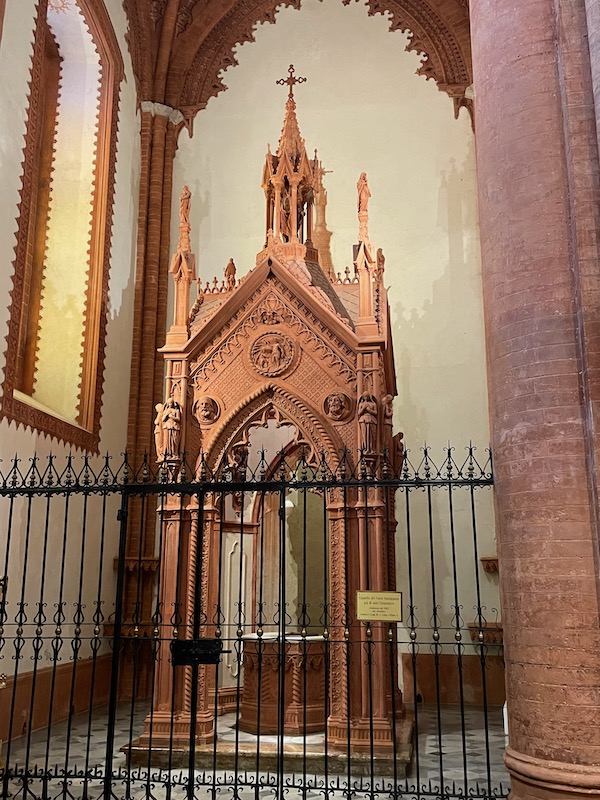

Lucy with Spring Flowers!
